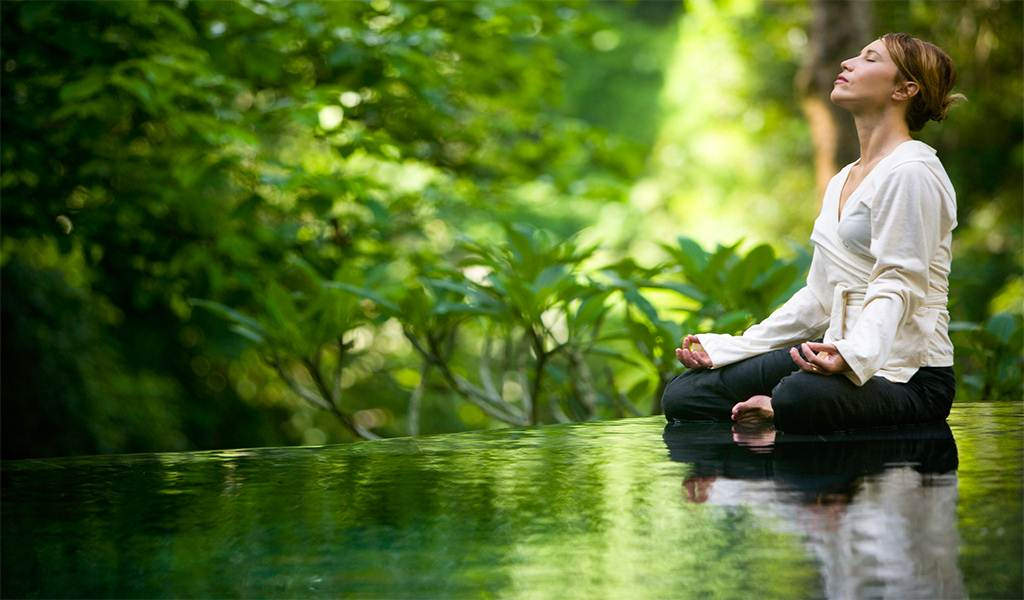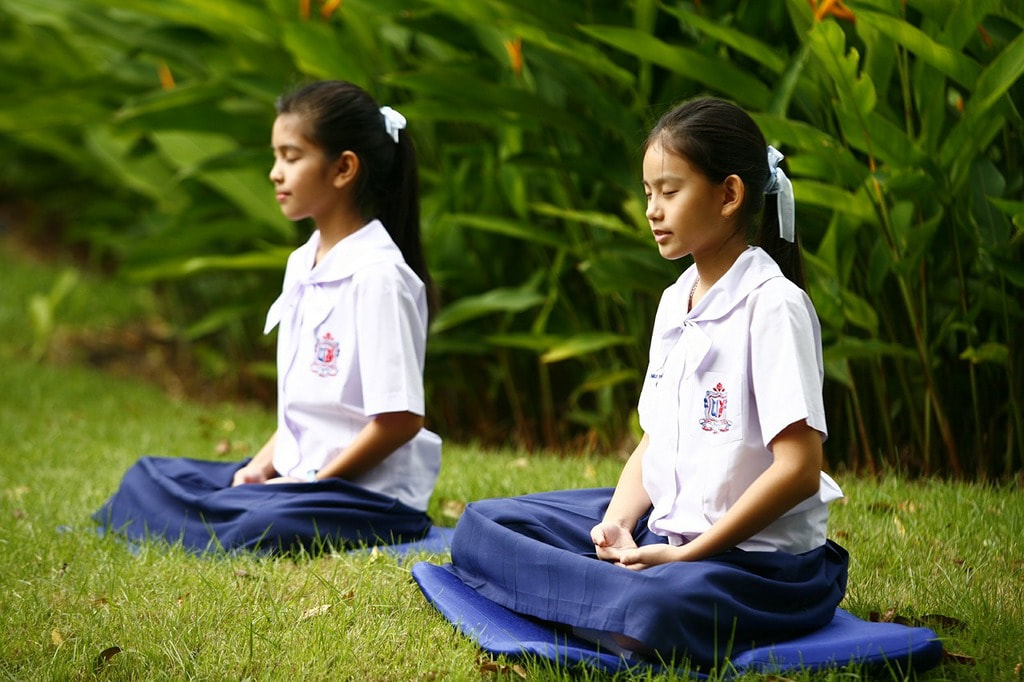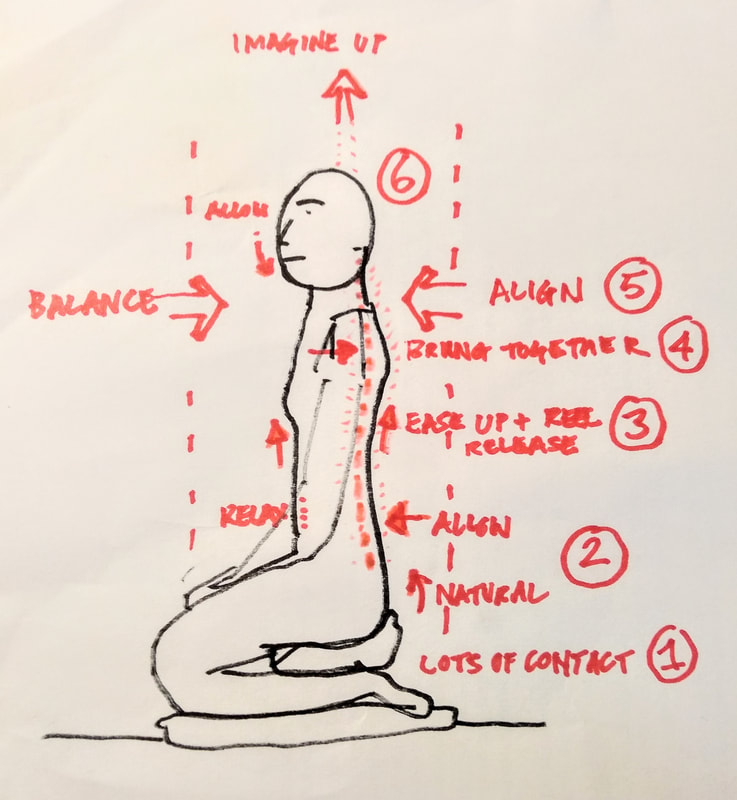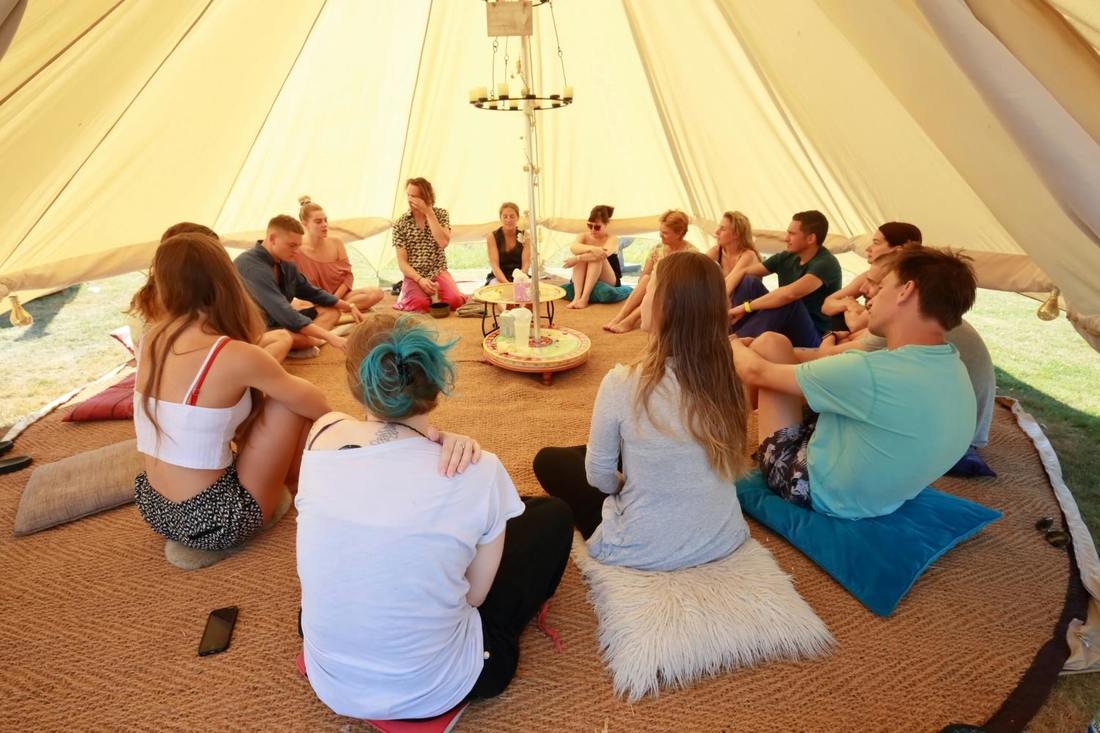MEDITATION POSTURE
There is a lot of bollocks on the internet about posture, featuring attractive young men and women sitting on rocks overlooking water, or on steps (!?) as if they've been sat there for hours contemplating wise enlightened attention. Utter marketing drivel. Please don't buy it or anything you read here that make you think you're not good enough.
The aim of this blog is to dispel that claptrap and keep it simple, concise and useful.
HOW SHOULD I SIT IN MEDIATION?
Firstly let's get it clear - meditation is a practice of mindfulness (paying attention to the present moment without judgement). Therefore there is no 'right' as that is a judgement. The aim is to sit in a way that is comfortable for your body, and which also represents the attitude you want to carry inside as you meditate. What you 'want' not what you 'need' to do.
This chosen attitude will dictate your posture. Interestingly there are theories that the external attitude is related to an internal attitude. One is affected by the other. That means your current posture is a reflection of your internal state AND you can affect your internal state by changing your posture. My experience is that by choosing a posture to reflect an attitude that I deeply enjoy I have created that inside and out as an automatic pattern. :)
There is a lot of bollocks on the internet about posture, featuring attractive young men and women sitting on rocks overlooking water, or on steps (!?) as if they've been sat there for hours contemplating wise enlightened attention. Utter marketing drivel. Please don't buy it or anything you read here that make you think you're not good enough.
The aim of this blog is to dispel that claptrap and keep it simple, concise and useful.
HOW SHOULD I SIT IN MEDIATION?
Firstly let's get it clear - meditation is a practice of mindfulness (paying attention to the present moment without judgement). Therefore there is no 'right' as that is a judgement. The aim is to sit in a way that is comfortable for your body, and which also represents the attitude you want to carry inside as you meditate. What you 'want' not what you 'need' to do.
This chosen attitude will dictate your posture. Interestingly there are theories that the external attitude is related to an internal attitude. One is affected by the other. That means your current posture is a reflection of your internal state AND you can affect your internal state by changing your posture. My experience is that by choosing a posture to reflect an attitude that I deeply enjoy I have created that inside and out as an automatic pattern. :)
INTENTION + ATTITUDE + VISUALISATION + BODILY FEEDBACK = POSTURE.
Intention: Why are you here? What are you hoping to feel, have or do within this meditation? You don't have to think about this every time, but for the first few it's worth considering. Generally my intention is to love myself, to be diligently focused and peaceful & loving towards what I find.
Attitude: What attitude would I like to bring to create that intention? Again, I'll get into the swing of this and barely think about it most day, but I'll often remind myself: I'm going to choose an attitude of 'self respect' and 'alertness'. Attitude and intention are nearly the same thing, but attitude is more of a feeling and way of 'being', whereas intention is more a 'doing'.
Visualisation: What image could help create the attitude? I like to use either, the image of wearing a cape, like superman, and tying it on creates a shoulder roll. Or the image of a string at the crown of my head getting lightly pulled up so that my spine hangs naturally. Another is to imagine a cushion of air between each vertebrae and then as you breathe in deep it inflates and as you breathe our some air is released, leaving the spine well adjusted and stacked. You can hold the visual image for 10-30 seconds to make it stick. You don't have to physically change anything, the body will do the work for you.
Bodily Feedback: What would this look like in posture? Let's give it a go and find out as we tune into the body. I start by choosing to kneel, with a straight back, relaxed face, slightly dipped chin. I then realise my shoulders are hunched and chest is collapsed so I correct this with a rib cage lift (engage the core muscles!) and roll my shoulders behind my back.
Posture: Many people like to sit cross-legged. I usually like to use a stool and kneel. I can change my posture in small ways (or completely) as I meditate. Moving doesn't mean I've failed. I've gradually learned when to tune in to discomfort, to watch and wait. Now I rarely move, but that is a natural product of years of experimentation. I've been meditating a long time and I'm used to this posture. Sometimes I try a different posture once in a while to shake things up. These could include:
1.Sukhasana (Easy Pose)
Basically legs crossed sitting with feet under the knees. Some all it Burmese.
2. The Lotus positions (seductive name!)
Quarter is basically legs crossed with feet on the calves. Half lotus would be one leg on top of the other thigh and one leg extended (awkward!) and full lotus is both feet resting on top of the opposite thighs. Pali term: Padmasana.
Intention: Why are you here? What are you hoping to feel, have or do within this meditation? You don't have to think about this every time, but for the first few it's worth considering. Generally my intention is to love myself, to be diligently focused and peaceful & loving towards what I find.
Attitude: What attitude would I like to bring to create that intention? Again, I'll get into the swing of this and barely think about it most day, but I'll often remind myself: I'm going to choose an attitude of 'self respect' and 'alertness'. Attitude and intention are nearly the same thing, but attitude is more of a feeling and way of 'being', whereas intention is more a 'doing'.
Visualisation: What image could help create the attitude? I like to use either, the image of wearing a cape, like superman, and tying it on creates a shoulder roll. Or the image of a string at the crown of my head getting lightly pulled up so that my spine hangs naturally. Another is to imagine a cushion of air between each vertebrae and then as you breathe in deep it inflates and as you breathe our some air is released, leaving the spine well adjusted and stacked. You can hold the visual image for 10-30 seconds to make it stick. You don't have to physically change anything, the body will do the work for you.
Bodily Feedback: What would this look like in posture? Let's give it a go and find out as we tune into the body. I start by choosing to kneel, with a straight back, relaxed face, slightly dipped chin. I then realise my shoulders are hunched and chest is collapsed so I correct this with a rib cage lift (engage the core muscles!) and roll my shoulders behind my back.
Posture: Many people like to sit cross-legged. I usually like to use a stool and kneel. I can change my posture in small ways (or completely) as I meditate. Moving doesn't mean I've failed. I've gradually learned when to tune in to discomfort, to watch and wait. Now I rarely move, but that is a natural product of years of experimentation. I've been meditating a long time and I'm used to this posture. Sometimes I try a different posture once in a while to shake things up. These could include:
1.Sukhasana (Easy Pose)
Basically legs crossed sitting with feet under the knees. Some all it Burmese.
2. The Lotus positions (seductive name!)
Quarter is basically legs crossed with feet on the calves. Half lotus would be one leg on top of the other thigh and one leg extended (awkward!) and full lotus is both feet resting on top of the opposite thighs. Pali term: Padmasana.
| Tips: Structure of checks for an aligned posture 1. Allow the floor to support your weight with lots of contact 2. Allow a natural tilt of the hips and curve of the lower back 3., Use the internal muscles to raise the rib-cage and then relax it, especially the belly 4. Ease the shoulder blades back together and then relax slightly 5. Align to centre yourself forward/back and left/right 6. Imagine a pull up from the crown of the head and thus allow the chin to naturally dip a few millimetres. 7. Keep the alignment and allow all other unnecessary tension to soften away. ** IN ALL POSTURES TAKE CARE OF YOUR BODY AND NOTICE PAIN. ADJUST AS NECESSARY | 3. Kneeling / Stool (Seiza in Japanese Zen) Kneel on cushion between your legs, or use a kneeling stool. I make these and sell them for £20. Let me know if you want one. They have cool hinges. The stools have a tilt to encourage the hips to tilt, so there is a natural bend in the lower back and the spine is stacked comfortably. Geisha used to sit for hours like this, without a stool or cushion! I don't recommend it for your knees. 4. Chair If you use a chair I recommend putting the feet flat, or if the chair is too low for that, cross them. If the chair is too high find a book or cushion to support the feet. Sit right back, but don't lean back into the back rest. Come off it. You can always use if if you get tired. A little cushion under your butt can help, and even a rolled up towel to support the lower back. 5. Lying Down You can lie on back or front, but try and use a posture that doesn't promote sleep, unless you want that. The hands can help with this by placing one on the chest and one on the belly, or both on the ground, palms up. Support the head and neck if you experience pain. Summary These are the overall postures, but remember the attitude is more important than the specifics. Do what feels 'right' (with the context I describe above) for you. In all of these postures the hands can relax as you wish. Some prefer palms open or fingers together as that has mental associations to energy moving or to openness. Ok, if that works for you do it. That is the general rule. So if you find lots of pain, give it a little time, breathe with it and see if it shifts. Only you know the difference between a little pain of muscles stretching and adapting vs damage occurring. Listen closely and adjust as necessary. |
Now that your sorted in posture wouldn't it be helpful if we would bring a helpful structure into meditation? Well I have good news - lets get back to basics!....
The Alphabet Meditation, by Neil Morbey
A - K: from Attitude to Kindness. A method to learen the steps of body scan meditation that will start with an intention, but lead to natural joy and kindness (I hope!) Here's the guidelines:
1. With each step repeat the word in your mind as you follow the breath. I sometimes combine it with 'here' and 'now'. Eg. thinking in time with breath: "Breathing...(in)...Here...(out)...Breathing...Now
2. Spend the most time on sections F,G and H. This is the 'peak' of the mediation. If you wanted to you could count breaths. I prefer not to.
Attitude, Breathing, Curious, Deep-breathing, Effortless, Feel-in, Gradually explore, Heart, Joy, Kindness
A: ATTITUDE - choose and observe the attitude of body posture, using visualisations. Adjust with feedback.
B: BREATHING - connect with the sensation of breathing, without changing it.
C: CURIOUS - cycle through common three senses (sounds, sight, smells)
D: DEEP-BREATHS - Take two reps of 5 deeper breaths and feel the difference in your belly, then chest.
E: EFFORTLESS - Feel contact with the floor, allowing it to support. Notice & soften tension in the face, shoulders and back.
F: FEEL-IN - Tune the attention into small areas inside your body, the pelvis, the belly, the chest, the throat and then the nostrils. Stay with that soft inner focus for some time, feeling the subtleties.
G: GRADUALLY-EXPLORING - Move the attention slowly, around the face and down the body, spending at least three breaths on each part. You could switch the mantra to replace 'here/now' with 'exploring'.
H: HEART - After you complete the scan spend some time at the heart. Many spiritual and scientific people consider this to be the powerhouse of the body and mind. I imagine the heart beating, or a light, flooding my system with loving life-force.
I: INCLUDE-ALL - Tune into the whole inner world allowing it all to be there. From there you could include the senses of the room again - sound, smell etc. Then you could go wider and imagine the body of another person near you - include them in your imagination. I imagine their heart beating. I go wider and wider, until the bell rings. This often feels amazing.
J: JOY - Open your eyes to enjoy colour and form, staying with the first thing you see, then expanding as you move your eyes. Keep with the breath and mantra to help: JOY...(in)... HERE...(out)...JOY...NOW... To me this reminds me that the world is her to be enjoyed and colour and form are part of that.
K: KINDNESS - Perceive your first movements as kindness to your body by giving it what it wants and by thanking yourself for taking your time. KINDNESS...(in)... HERE...(out)... Once you bring your attention up and into normal living you could decide how you're going to bring kindness today.
This is a basic structure and it is malleable. Make it fit you rather than crushing yourself to fit it. The principles are simple - keep it simple, relax your judgements and enjoy. Find what works for you through playful experimentation!
A - K: from Attitude to Kindness. A method to learen the steps of body scan meditation that will start with an intention, but lead to natural joy and kindness (I hope!) Here's the guidelines:
1. With each step repeat the word in your mind as you follow the breath. I sometimes combine it with 'here' and 'now'. Eg. thinking in time with breath: "Breathing...(in)...Here...(out)...Breathing...Now
2. Spend the most time on sections F,G and H. This is the 'peak' of the mediation. If you wanted to you could count breaths. I prefer not to.
Attitude, Breathing, Curious, Deep-breathing, Effortless, Feel-in, Gradually explore, Heart, Joy, Kindness
A: ATTITUDE - choose and observe the attitude of body posture, using visualisations. Adjust with feedback.
B: BREATHING - connect with the sensation of breathing, without changing it.
C: CURIOUS - cycle through common three senses (sounds, sight, smells)
D: DEEP-BREATHS - Take two reps of 5 deeper breaths and feel the difference in your belly, then chest.
E: EFFORTLESS - Feel contact with the floor, allowing it to support. Notice & soften tension in the face, shoulders and back.
F: FEEL-IN - Tune the attention into small areas inside your body, the pelvis, the belly, the chest, the throat and then the nostrils. Stay with that soft inner focus for some time, feeling the subtleties.
G: GRADUALLY-EXPLORING - Move the attention slowly, around the face and down the body, spending at least three breaths on each part. You could switch the mantra to replace 'here/now' with 'exploring'.
H: HEART - After you complete the scan spend some time at the heart. Many spiritual and scientific people consider this to be the powerhouse of the body and mind. I imagine the heart beating, or a light, flooding my system with loving life-force.
I: INCLUDE-ALL - Tune into the whole inner world allowing it all to be there. From there you could include the senses of the room again - sound, smell etc. Then you could go wider and imagine the body of another person near you - include them in your imagination. I imagine their heart beating. I go wider and wider, until the bell rings. This often feels amazing.
J: JOY - Open your eyes to enjoy colour and form, staying with the first thing you see, then expanding as you move your eyes. Keep with the breath and mantra to help: JOY...(in)... HERE...(out)...JOY...NOW... To me this reminds me that the world is her to be enjoyed and colour and form are part of that.
K: KINDNESS - Perceive your first movements as kindness to your body by giving it what it wants and by thanking yourself for taking your time. KINDNESS...(in)... HERE...(out)... Once you bring your attention up and into normal living you could decide how you're going to bring kindness today.
This is a basic structure and it is malleable. Make it fit you rather than crushing yourself to fit it. The principles are simple - keep it simple, relax your judgements and enjoy. Find what works for you through playful experimentation!




